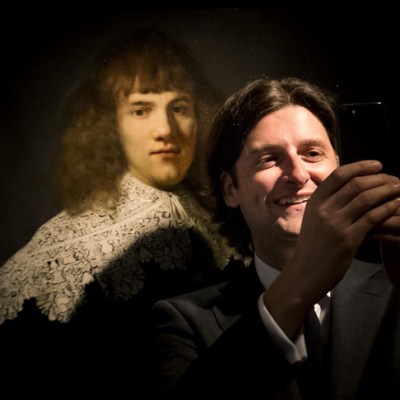The central figure in Oeke Hoogendijk’s new documentary My Rembrandt is silent and his screen time is minimal. There’s someone who might be him in the background of a painting, but as no one’s sure who painted it, it might not be him at all. This silence doesn’t matter though; the film isn’t about Rembrandt. Rather his work is the McGuffin uniting the owners and would-be owners of Rembrandts who are the subjects of this engaging film.
‘When I’m standing next to it, it’s palpable history. When I move out of the picture [out of shot], it’s just a painting. That’s because this is the first Jan Six and I’m the tenth,’ says Jan Six (the tenth), standing next to Rembrandt’s Portrait of Jan Six (the first) in his elegant Amsterdam townhouse. But it’s his son, Jan Six (the 11th), an art dealer, whose quest to identify the creator of one painting, Portrait of a Young Gentleman, forms a major strand of Hoogendijk’s film. His desire to have his instincts confirmed when it comes to identifying Rembrandt’s hand drives the parts of the film in which he features. As the story of the Portrait of a Young Gentleman unfolds, Six explains to two journalists, ‘It’s this hunt. The naughty boy telling the teacher: You’re wrong and I’m right. This is my catharsis. As a boy from the Six family I was always treated like: “Little Jan has it easy.” No, Little Jan worked five times harder than all the others and he was proved right. That is the story.’ During a trip to the Rijksmuseum, where inscrutable experts scrutinise Portrait of a Young Gentleman, Six isn’t a calm, assured art dealer; more like ‘Little Jan’ striving to be proven right. Hoogendijk follows a man feeling the pressure of the ten Jan Sixes who came before, and the need to define himself among them.
Although Jan Six’s quest is at the heart of the documentary, other owners of Rembrandts offer various insights into a club Six may be about to belong to. At the Rjiksmuseum, we follow the museum’s then director Wim Pijbes and director of collections Taco Dibbits, who are involved in the fraught purchase of Portrait of Marten Soolmans and Portrait of Oopjen Coppit, a pair of paintings that have been in the French Rothschild family for more than a century. The purchase is so important that it develops into a small incident between the French and Dutch governments, when it becomes apparent the Louvre can’t raise the money required to keep the pieces in Paris. The prestige of owning a Rembrandt is clearly something that is as valued in international circles as it is in private ones.
The Duke of Buccleuch at home in Dumlanrig Castle. Above the fireplace hangs ‘An Old Woman Reading’ by Rembrandt. Courtesy Dogwoof

We also meet the Duke of Buccleuch at home, in his castle in Scotland. His story revolves around the moving of his family Rembrandt, An Old Woman Reading, from one room of the castle to another. The visit of Dibbits from the Rijksmuseum to advise on this move speaks to the regard in which owners of Rembrandts are held. Incidentally, Dibbits isn’t present to check on Portrait of a Young Gentleman when Six visits the museum; Six must sign in at the entrance like everyone else.
Finally, there’s Thomas Kaplan, owner of the largest private collection of Rembrandts. His passion for his collection is unmistakable, and you get the impression that when he was younger he shared Six’s drive and ambition: I don’t imagine one comes by 11 paintings by Rembrandt without a little bit of effort. Kaplan’s admission that after purchasing Woman with a White Cap he held the frame and kissed her on the lips is not something many can claim to have done. But ownership, it seems, permits certain privileges.
My Rembrandt is streaming and in cinemas from 14 August.



